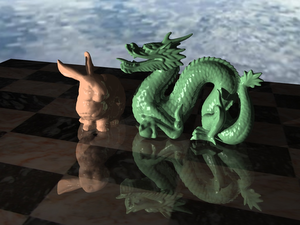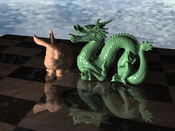Information
- Publication Type: Master Thesis
- Workgroup(s)/Project(s):
- Date: April 2013
- TU Wien Library:
- First Supervisor:
Abstract
In computer graphics, ray tracing is a well-known image generation algorithm which exists since the late 1970s. Ray tracing is typically known as an offline algorithm, which means that the image generation process takes several seconds to minutes or even hours or days.In this thesis I present a ray tracer which runs in real-time. Real-time in terms of computer graphics means that 60 or more images per second (frames per second, FPS) are created. To achieve such frame rates, the ray tracer runs completely on the graphics card (GPU). This is possible by making use of Nvidia’s CUDA -API. With CUDA, it is possible to program the processor of a graphics card similar to a processor of a CPU. This way, the computational power of a graphics card can be fully utilized. A crucial part of any ray tracer is the acceleration data structure (ADS) used. The ADS is needed to efficiently search in geometric space. In this thesis, two variants of so called kD-Trees have been implemented. A kD-Tree is a binary tree, which divides at each node a given geometric space into two halves using an axis aligned splitting plane. Furthermore, a CUDA library for the rendering engine Aardvark, which is the in-house rendering engine at the VRVis Research Center, was developed to access CUDA functionality from within Aardvark in an easy and convenient way.
The ray tracer is part of a current software project called “HILITE” at the VRVis Research Center.
Additional Files and Images
Weblinks
No further information available.BibTeX
@mastersthesis{Voglsam_2013_RRT,
title = "Real-time Ray Tracing on the GPU - Ray Tracing using CUDA
and kD-Trees",
author = "G\"{u}nther Voglsam",
year = "2013",
abstract = "In computer graphics, ray tracing is a well-known image
generation algorithm which exists since the late 1970s. Ray
tracing is typically known as an offline algorithm, which
means that the image generation process takes several
seconds to minutes or even hours or days. In this thesis I
present a ray tracer which runs in real-time. Real-time in
terms of computer graphics means that 60 or more images per
second (frames per second, FPS) are created. To achieve such
frame rates, the ray tracer runs completely on the graphics
card (GPU). This is possible by making use of Nvidia’s
CUDA -API. With CUDA, it is possible to program the
processor of a graphics card similar to a processor of a
CPU. This way, the computational power of a graphics card
can be fully utilized. A crucial part of any ray tracer is
the acceleration data structure (ADS) used. The ADS is
needed to efficiently search in geometric space. In this
thesis, two variants of so called kD-Trees have been
implemented. A kD-Tree is a binary tree, which divides at
each node a given geometric space into two halves using an
axis aligned splitting plane. Furthermore, a CUDA library
for the rendering engine Aardvark, which is the in-house
rendering engine at the VRVis Research Center, was developed
to access CUDA functionality from within Aardvark in an easy
and convenient way. The ray tracer is part of a current
software project called “HILITE” at the VRVis Research
Center.",
month = apr,
address = "Favoritenstrasse 9-11/E193-02, A-1040 Vienna, Austria",
school = "Institute of Computer Graphics and Algorithms, Vienna
University of Technology ",
URL = "https://www.cg.tuwien.ac.at/research/publications/2013/Voglsam_2013_RRT/",
}

 Poster
Poster Thesis
Thesis


